|
|
SANSKRIT IMAGES
By Permission From:
TOBIFUDO

Handbook on Viewing Buddhist Statues
A totally wonderful
book, by Ishii Ayako.
The top image
on this page was
scanned from this
book; Japanese language only; 192 pages; 80 or so
color photos.
Click here to
buy book at Amazon
Japanese Text Below
仏像の見方ハンドブック
石井 亜矢子 (著)
by Ishii Ayako
|
|

BIRUSHANA BUDDHA, BIRUSHANA NYORAI
Birushana 毘盧舍那 (Transliteration of Sanskrit “Vairocana”)
Makabirushana 摩訶毘盧舍那 (Transliteration of Sanskrit “Mahāvairocana”)
Other spellings: Birushana 毘盧遮那, Rushanabutsu 盧舎那仏 or 盧遮那佛
The deity "belonging to or coming from the sun; the great illuminating one.”
Translated as Dainichi Nyorai 大日如来, the supreme deity
of Japan's Shingon Sect of Esoteric Buddhism (Mikkyō 密教).
ORIGIN = INDIA
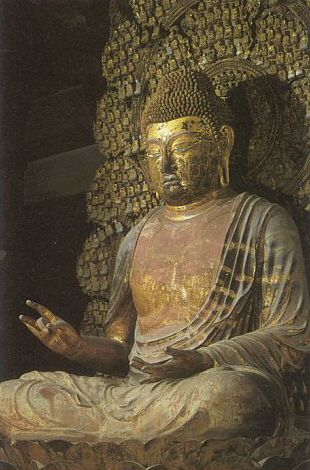
Rushana (Birushana)
Nara Era 710 to 794 AD, at Tōshōdai-ji Temple 唐招堤寺
Wood, H = 304.5 cm
As early as the Heian Period (794 - 1192 AD), devotees of Esoteric Buddhism worshipped Dainichi Nyorai (Skt. = Vairocana) as the central Buddha of the universe, the so-called Cosmic Buddha. What is often forgotten, however, is that Dainichi 大日如來 (Great Sun Buddha) is the translation of Sanskrit “Vairocana,” while Birushana is the transliteration. Vairocana means “belonging to / coming from the sunlight.” It was transliterated into Chinese as Pílúshènà and into Japanese as Birushana.
Birushana Nyorai was one of the earliest Buddhist deities to arrive in Japan in the 6th and 7th centuries AD. In some sects, Birushana is considered to be the reward-body of Shakyamuni Buddha, the Historical Buddha. In others, Birushana represents the true Buddha body, the spiritual body of Buddha-truth, which is akin to light pervading the entire universe. Birushana appears in the Kegon-kyō 華厳経 (Flower Garland Sutra; Skt. = Avatamsaka Sutra) and other texts, where the deity is described as encompassing everything in the cosmos.
The world-famous Nara Daibutsu 奈良大仏 (Big Buddha of Nara), completed in 752 AD, is none other than Birushana. Japan’s other surviving Big Buddha statue from early times is the Big Buddha of Kamakura. Both statutes are about 15 meters high.
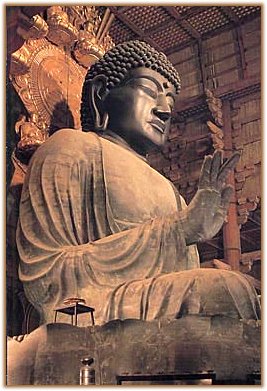
NARA DAIBUTSU 奈良の大仏- 15 meters in height, gilt bronze
The famous Big Buddha statue at Tōdai-ji Temple 東大寺 is an effigy of Birushana.
Also known as the Rushana Daibutsu 盧舎那大仏 or Nara no Daibutsu 奈良の大仏 (Great Buddha of Nara).
Photo by Yabuuchi Satoshi (Uwamuki Project).

Says the Yomiuri Shimbun. The Nara Daibutsu, whose image embodies the Buddha Birushana, dates back to 752. Over the centuries, the statue has been damaged in various battles, but has always been restored afterward. The body of the statue was reconstructed in 1185, and the 5.3-meter-high head was rebuilt in 1692. At 15 meters, it is the largest gilt bronze statue in the world. From www.yomiuri.co.jp/nanjo/nanjo50.htm.
Below Text From: www1.sphere.ne.jp/naracity/e/buddha/e_buddha01.html
In order to drive away a general feeling of unrest caused by successive revolts, and to secure the protection and welfare of the nation with the help of Buddhism, Emperor Shōmu 聖武 (reigned +724 to 749) promoted the construction of a provincial temple in each province and made a decision to build a great image of Birushana Butsu, or Buddha Vairocana, at Tōdai-ji Temple. The grand dedication ceremony was held in the 4th year of the Tempyo-Katsuho era (752).
THE BIG BUDDHA of Tōdai-ji Temple in Nara is famous for the great image of Birushana Buddha, a symbol of Nara. The temple building itself is the largest existing wooden structure in the world. The present temple building was reconstructed in the middle of the Edo Era (1603-1867). It is 57 meters wide, 50 meters deep, and 48 meters tall. It is an imposing structure when you see it close at hand. But it is only two-thirds the original size.
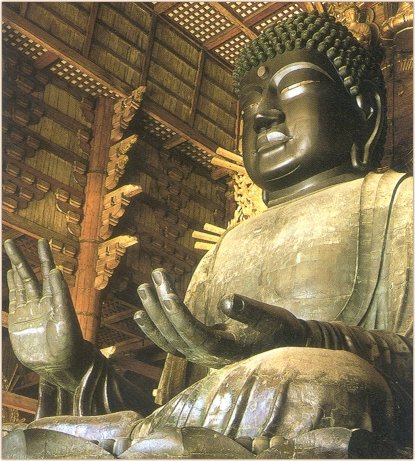
Rushana, Edo Period Statue, in Nara at Tōdai-ji
Photo courtesy of Handbook on Viewing Buddhist Statues
A totally wonderful book, by Ishii Ayako. The above image
was scanned from this book; Japanese language only
192 pages; 80 or so color photos. Click here to buy book at Amazon
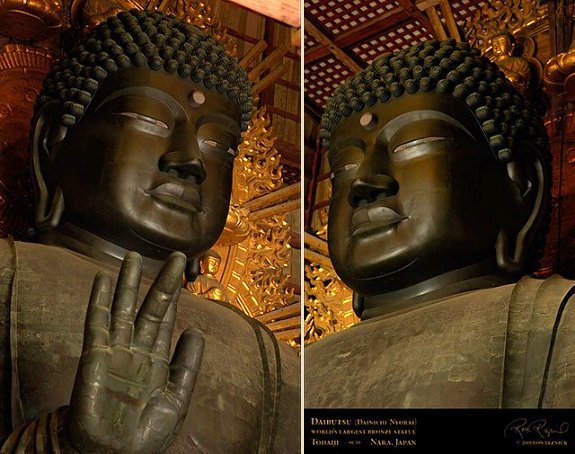
ABOVE AND BELOW - PHOTOS BY RON REZNICK
Bust of Rushana Nyorai at Tōdai-ji Temple in Nara. The body of the statue was reconstructed in 1185,
and the 5.3-meter-high head was rebuilt in 1692. For more photos of Tōdai-ji Temple by Ron Reznick, please
visit his web gallery at digital-images.net. For photos of Tōdai-ji, click here. For Japan-related photo, click here.
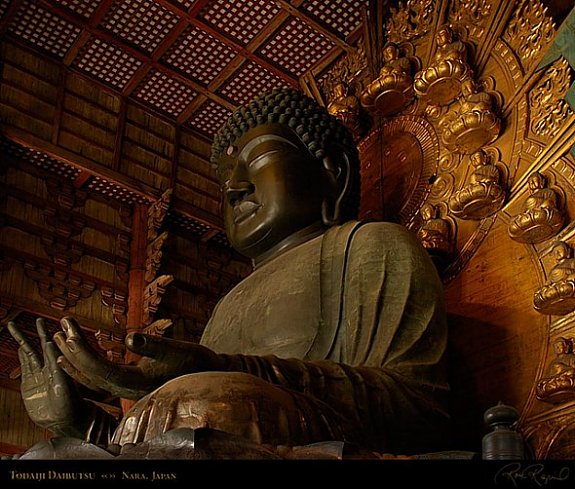

BELOW: From the Encyclopedia of Japan. Todaiji. Major monastery-temple belonging to the Kegon sect of Buddhism. It was erected by order of the Emperor Shomu (r 724-749) in Nara, the capital of Japan from 710 to 784, to become the most important religious institution within the network of provincial monasteries and convents (kokubunji) throughout Japan. Immense in scale, Todaiji represented the culmination of Buddhist architecture under imperial sponsorship. The principal image of the temple, a colossal bronze statue popularly called the Nara Daibutsu (Great Buddha of Nara), completed in 752, was installed in its daibutsuden (great Buddha hall). The image embodied the Buddha Birushana (Skt: Vairocana), who was regarded by the Kegon sect as the cosmic, central Buddha. Over the centuries the icon was severely damaged several times and finally restored to its present form in 1692. Most of the extant Todaiji buildings are restorations of earlier structures.
The origin of Todaiji goes back to the Kinshoji, a temple that had existed in the eastern sector of the present Todaiji compound. Here, Roben (689-773), a scholar-monk of the Kegon sect who was to become the first abbot of Todaiji, had been active in 733. Roben is commemorated by a portrait-statue made around 1019 and kept in the Kaisando (founder's hall). The kondo (main hall) of Kinshoji probably is the extant inner sanctuary of the hokkedo (lotus hall), popularly known as the Sangatsudo (Third Month Hall), where the Lotus Sutra (Hokekyo) is chanted yearly during the third month (sangatsu). The main icon of the hokkedo is the Fukukensaku Kannon, a splendid, dry-lacquer statue, made around 746. In 741 the Kinshoji became the provincial monastery-temple for Yamato Province (now Nara Prefecture). At that time the temple was renovated and renamed Konkomyoji after the Sutra of the Golden Light (J: Konkomyo kyo).
The temple was first referred to as Todaiji in 747, when construction of its major buildings was begun. An immense area extending over seven city blocks was allocated for the Todaiji compound. The eastern sector stretched into the Kasuga hills. The main entrance was through the nandaimon (great south gate), which was on an axis with the daibutsuden. Between the nandaimon and the chumon (inner gate) that led to the precinct of the daibutsuden were two seven-storied pagodas, one to the east and the other to the west, each 100 meters (328.1 ft) high. On an axis to the north of the daibutsuden, flanked by a belfry and a sutra repository, was the kodo (lecture hall), enclosed on three sides by monks' quarters that were connected to a refectory by a corridor. In 754 a hall for the ordination of monks, the kaidan'in, was established by Ganjin (Ch: Jianzhen or Chien-chen). It burned down three times; the present one dates from 1731. On its altar are placed images of the Shitenno (Four Heavenly Kings), which are outstanding examples of Tempyo-era (729-749) clay modeling. By 798 the vast compound of Todaiji and its buildings were completed. According to Todaiji records, 50,000 carpenters, 370,000 metal workers, and 2.18 million laborers worked on its construction and furnishings. The enormous expenses virtually brought the nation to the brink of bankruptcy.
Little remains of the 8th-century buildings of Todaiji except the Tegai Gate of the western wall and the inner sanctuary of the hokkedo. After the destruction of the Daibutsuden, the towering pagodas, and most of the other buildings in 1180, the Todaiji was reconstructed under the direction of the abbot Shunjobo Chogen (1121-1206), in a style Chogen had observed in Southern Song (Sung; 1127-1279) China. This new architectural style, known as the “great Buddha style” (daibutsuyo) or the “Indian style” (tenjikuyo), is well preserved in the nandaimon, for which in 1203 the famed sculptors Unkei and Kaikei made the powerful guardian statues of the Nio (Benevolent Kings). After great damage in 1567, the rebuilding of Todaiji was sponsored by the Tokugawa shogunate in 1692. The daibutsuden visible today dates for the most part from 1709 and lacks the stylistic uniformity and refinement of its 8th-century predecessor. However, it remains to this day the most prominent edifice in Nara and is generally regarded as the largest wooden structure in the world. The Shosoin, a storehouse located on the grounds of Todaiji, houses several thousand precious ornamental and fine-art objects from the 8th century. Todaiji is also famous as the temple where Omizutori, a central rite in the Buddhist religious calendar, is conducted each year in early spring.

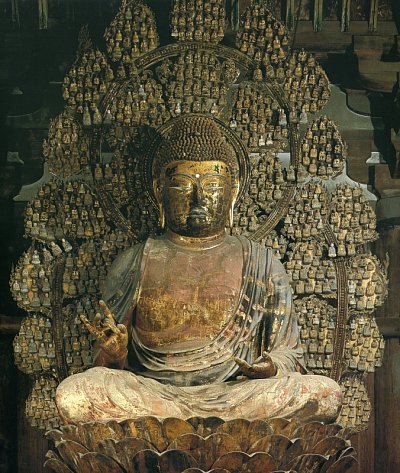
Rushana Buddha 盧舎那仏. Also known as Birushana 昆盧遮那
Hollow Dry Lacquer (Jp. = Dakkatsu Kanshitsu 脱活乾漆) with gold foil using shippaku 漆箔 technique.
H = 304.5 cm, Tōshōdai-ji Temple 唐招堤寺, Nara Era. Photo by Ogawa Kōzō

RELATED MATTERS
- One reason for Japan’s early embrace of Buddhism involved the notion of “building spiritual merit” for oneself and others. Known as Chishiki 知識 in Japanese and translated as “pious contribution.” Originally a Sanskrit term (mitra) meaning “friend” or “companion,” in Japan it came to designate any person who spread the Buddhist teachings in hopes of saving others. Chishiki was a means to accumulate religious and spiritual merit and thus improve one’s own chance of salvation. It came in many forms, from those who founded and maintained temples, to those who devoted their money, land, or efforts to advance the cause of Buddhism. The Chishiki ideal came to prominence with Emperor Shōmu 聖武 (Shomu; reigned +724 to 749) in Japan’s Nara period. Shōmu ordered the construction of a giant bronze Buddha statue known as the Nara Daibutsu 奈良大仏, one to be financed by the “pious contributions” of devotees, parishioners, and lay people. The “chishiki” ideal meant that the benefits of constructing and maintaining the giant statue would accrue to anyone who participated in the endeavor, no matter how small their contribution. The concept resonated deeply among Japan’s nobility and common people. Even today, the Chishiki ideal remains a major pillar of Buddhist practice in Japan.
The Nara period, moreover, might rightfully be called the Shōmu Era, for the capital in Nara during the reign of Emperor Shōmu 聖武 covered about 35 square miles and was home to more than a million people. It represented Japan's first real age of imperial splendor. During his rule, Emperor Shōmu (also spelled Shoumu or Shomu) ordered the establishment of a nationwide system of provincial monasteries (kokubunji 国分寺) and nunneries (kokubunniji 国分尼寺), with each provincial temple directly answerable to Tōdaiji Temple 東大寺 in Nara, the head of all state-established temples. Emperor Shōmu also spearheaded the construction of the Nara Daibutsu (Great Buddha Statue) at Tōdaiji Temple. This giant bronze statue was itself inspired by a giant Buddha carving in the cliffs of Longmen 竜門 (near Chang'an), again underscoring Japan's enchantment with Chinese culture.
- Says scholar Ross Bender in the Premodern Japanese Studies Forum: “The Tamukeyama Hachiman 手向山神社 shrine to the east of Tōdaiji Temple is not as well-known as it might be, but it is home to the guardian deity of Tōdaiji (and Tōdaiji’s Big Buddha statue of Birushana, known as the Big Buddha of Nara (Nara Daibutsu 奈良大仏). Although the shrine’s present location dates from 1237, it is the heir of the shrine built when the Shintō deity named Hachiman came to Nara in Tempyo Hoji 1 (8th century). The shrine’s annual festival is the Tegai-e 手掻会 (or Tenkai-e 転害会), held on October 5, and I believe it is the only time the famous statue of Sogyo Hachiman in the Hachiman-den (Hachiman Hall) on the Tōdaiji grounds is available for viewing. The shrine itself should not be missed although often is when visiting Nara. Some recent photos of the shrine are here.” <end quote from Bender>
- In +1180, Tōdaiji Temple was burnt to the ground by the Taira clan during their battles with the Minamoto, and the head and right hand of the Great Tōdaiji Daibutsu Statue suffered damage. In +1181, restoration work began under the director Fujiwara Yukitaka. Priest Shunjobo Chogen collected contributions to finance the project, and the craftsmen Ch’en Ho-ch’ing was brought over from Sung-era China to do the casting. Repair was completed in +1185, and in the eighth month of that year an official celebration was held to commemorate the newly repaired Big Buddha Statue of Nara. Soon thereafter, work began on the reconstruction of the Daibustsuden (Big Buddha Hall), were the statue would be housed.
- Protecting the great hall that houses the Big Buddha statue of Birushana Nyorai are two giant effigies (each 26-feet tall) of the Nio protectors, whose construction was directed by famed sculptors Unkei and Kaikei.
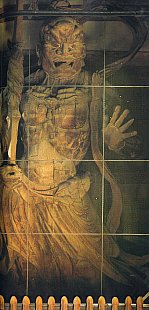 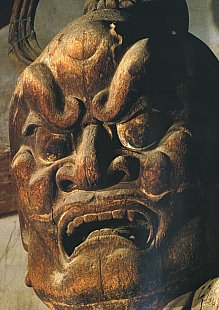
Agyō 阿形 H = 836.3 cm., aka Kongō Rikishi 金剛力士
Wood with paint (saishiki 彩色). Made by the famous Kei school of sculptors (including
Unkei and Kaikei) in the Kamakura Era. Tōdaiji Temple 東大寺, Nara. Photos from temple catalogs.
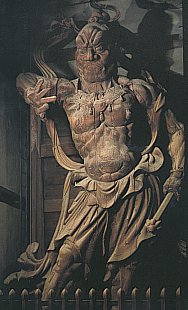 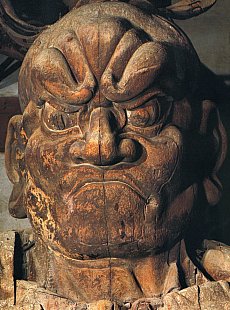
Ungyō 吽形 H = 842.3 cm, aka Kongō Rikishi 金剛力士
Wood with paint (saishiki 彩色). Made by the famous Kei school of sculptors (including
Unkei and Kaikei) in the Kamakura Era. Tōdaiji Temple 東大寺, Nara. Photos from temple catalogs.

LEARN MORE
- Click here for more photos of Dainichi (aka Birushana)
- Says JAANUS: Rushanabutsu 盧舎那仏. Also read Roshanabutsu (lit. Rushana Buddha). Rushana is an abbreviation of Birushana 昆盧遮那, which in turn is a transliteration of the Skt. Vairocana, which in the context of Esoteric Buddhism (mikkyou 密教) usually corresponds to Dainichi 大日. The appellation Rushana is normally applied to Vairocana in his role as expositor of the KEGONKYOU 華厳経 (Sk: Avatamsaka-sutra; Flower Ornament Scripture) and related texts, where he is decribed as pervading the entire universe. According to the BONMOUKYOU 梵網経 (Ch: Fanwangjing; Brahma Net Scripture), for example, Variocana is said to reside in the "Lotus Matrix World" rengezou sekai 蓮華蔵世界, which is surrounded by one thousand petals, each constituting a separate world with its own emanation of Vairocana in the form of Shaka 釈迦; each of these one thousand worlds further contains ten billion worlds, each again with its own Shaka expounding the BONMOUKYOU. The political implications of this hierarchical structure were not lost on the rulers of either China or Japan: The Huayan (Jp: Kegon 華厳) sect in China, based on the KEGONKYOU, enjoyed the patronage of especially Empress Wu (Zetian Wuhou, Jp; Sokuten Bukou 則天武后; r. 690-705), while in Japan Emperor Shoumu 聖武 (701-56) attempted to reunite a nation that had become increasingly restless through the construction of a huge image of Rushanabutsu as a symbol of national unity, and he himself subsequently took the religious name of Rushana. The imperial edict for casting the image was issued in 743, actual casting began in 747 and was completed in 749, and the dedication ceremony was performed in 752, with donations to pay for the project having been solicited throughout the land. The finished seated bronze statue, generally known as Rushana Daibutsu 盧舎那大仏 or Nara no Daibutsu 奈良の大仏 (Great Buddha of Nara) and enshrined in the Great Buddha Hall, Daibutsuden 大仏殿 of Toudaiji 東大寺 in Nara, is 14.85m in height, with the left hand placed outstretched on the left knee and the right hand lightly raised in the gesture of preaching, and the lotus petals of the base are engraved with figures of Shaka preaching as described in the sutra. Unfortunately this statue has been twice damaged by fire, and the greater part of it as it stands today has been restored. This is the most renowned image of Rushanabutsu; another is the dry-laquer image in the Golden Hall (Kondou 金堂) at Toushoudaiji 唐招堤寺, also in Nara, and dating from the late Nara period (late 8c). <end JAANUS quote>
- Says Manjushri.com: Japanese lit. "School of the Flower Garland"; school of Japanese Buddhism. Corresponds to the Chinese Hua-yen school. It was brought to Japan from China around 740 by Shen-hsiang (Jap., Shinsho). The first Japanese representative of the Kegon school was Roben (689-722). Emperor Shomu (724-748) wanted to rule Japan according to the principles of Kegon. He had the Todai-ji (Great Eastern Monastery) built in Nara, in which there is a colossal image of the buddha Vairochana (Jap., Birushana). This monastery is still today the center of the Kegon school.
The Kegon school was of extraordinary importance for the development of Japanese Buddhism. The fundamental sutra for this school, the Avatamsaka Sutra (Japanese: Kegon-kyo) was politically construed and taken as a confirmation of the ideal of the unity of the state and of the national-political coloration of Japanese Buddhism. <end Manjushri.com quote>
毘盧舎那如来 (毘盧遮那仏)
毘盧舎那如来・毘盧遮那仏・盧舎那仏・盧遮那仏
摩訶毘廬遮那如来 (まかびるしゃなにょらい)
毘廬遮那は光り輝く太陽を意味します

|
|